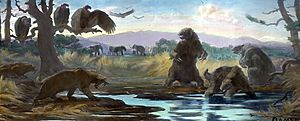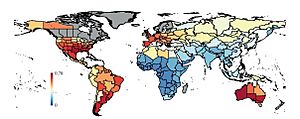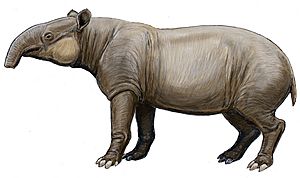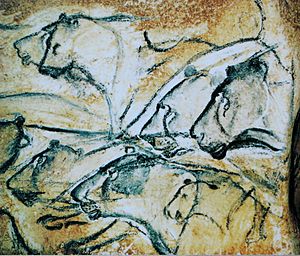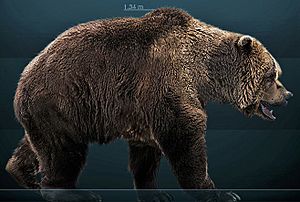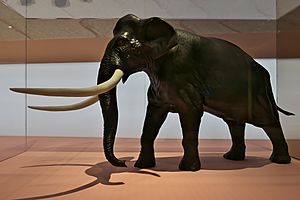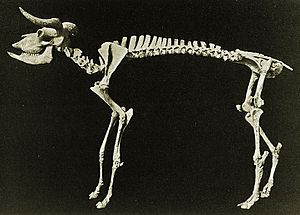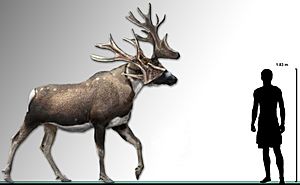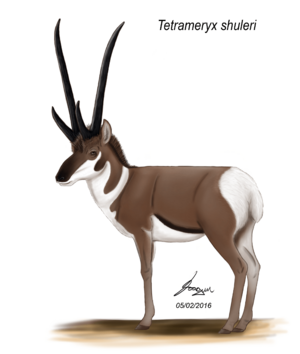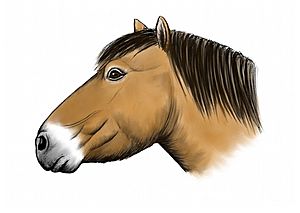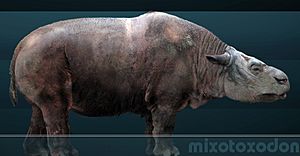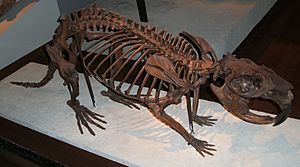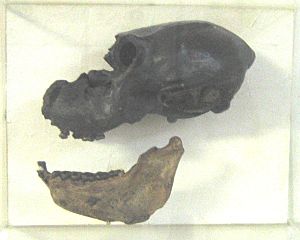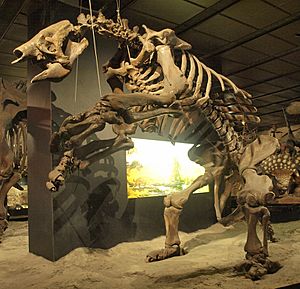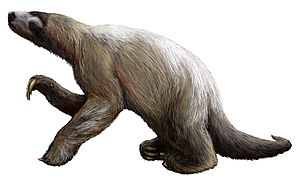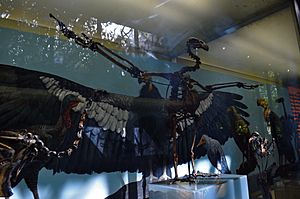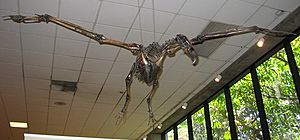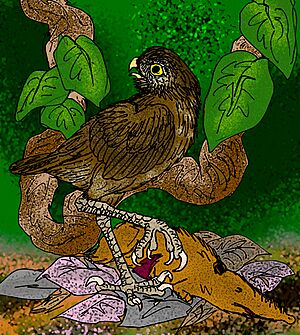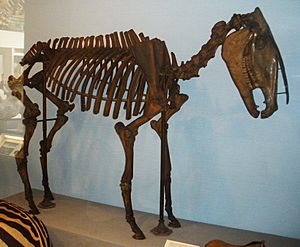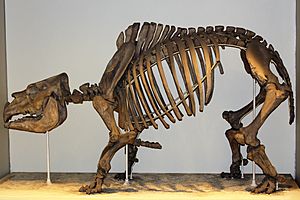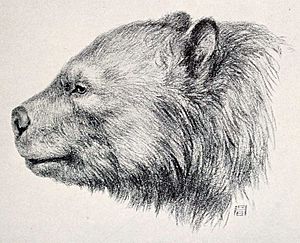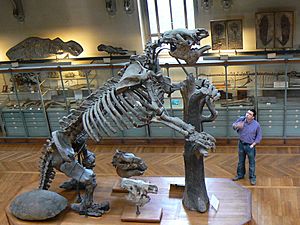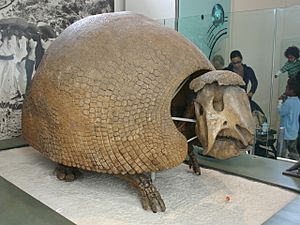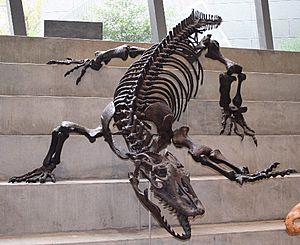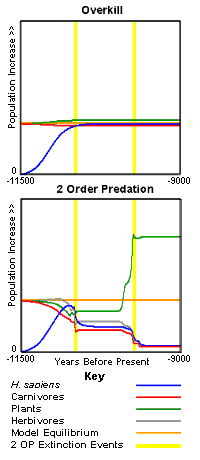Quaternary extinction event facts for kids
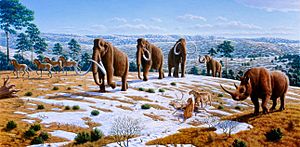
Imagine a time when giant animals roamed the Earth! This was during the end of the Late Pleistocene and the start of the Holocene periods, roughly 50,000 to 10,000 years ago. Many huge animal species, called megafauna, disappeared forever. This event caused a big drop in the number and types of animals all over the world.
What made these giant animals vanish? Scientists believe it was a mix of two main things: humans and changes in the climate. Humans might have hunted these animals too much, or changed their environment. The climate also changed a lot, with ice ages coming and going. The exact reasons are still a big debate among scientists!
The extinctions happened differently in different places. In Australia-New Guinea, many animals started disappearing about 50,000 years ago. In the Americas, it happened around 13,000 years ago. Both times match when early humans first arrived in these areas. In northern Eurasia, the extinctions happened slowly over thousands of years. Overall, about 65% of all megafauna species worldwide went extinct. This number was even higher in North America (72%), South America (83%), and Australia (88%). Places like Africa and parts of Asia had fewer extinctions.
Contents
Giant Animals Disappearing Around the World
How Many Animals Were Lost?
The table below shows how many large and medium-sized mammals went extinct in different parts of the world between 40,000 and 4,000 years ago. You can see that the biggest animals (over 1,000 kg) were hit the hardest!
| Region | Giants (over 1,000 kg) |
Very large (400–1,000 kg) |
Large (150–400 kg) |
Moderately large (50–150 kg) |
Medium (10–50 kg) |
Total | Regions included | ||||||||||||
|---|---|---|---|---|---|---|---|---|---|---|---|---|---|---|---|---|---|---|---|
| Start | Loss | % | Start | Loss | % | Start | Loss | % | Start | Loss | % | Start | Loss | % | Start | Loss | % | ||
| Africa | 6 | −1 | 16.6% | 4 | −1 | 25% | 25 | −3 | 12% | 32 | 0 | 0% | 69 | −2 | 2.9% | 136 | -7 | 5.1% | Africa south of the Sahara and Arabia |
| South and Southeast Asia | 5 | −2 | 40% | 6 | −1 | 16.7% | 10 | −1 | 10% | 20 | −3 | 15% | 56 | −1 | 1.8% | 97 | -8 | 8.2% | Indian subcontinent, Southeast Asia, and southern China |
| Europe and Northern Asia | 8 | −8 | 100% | 10 | −5 | 50% | 14 | −5 | 35.7% | 23 | −3 | 15% | 41 | −1 | 2.4% | 96 | -22 | 22.9% | Eurasia and North Africa |
| North America | 5 | −5 | 100% | 10 | −8 | 80% | 26 | −22 | 84.6% | 20 | −13 | 65% | 25 | −9 | 36% | 86 | -57 | 66% | North America |
| South America | 9 | −9 | 100% | 12 | −12 | 100% | 17 | −14 | 82% | 20 | −11 | 55% | 35 | −5 | 14.3% | 93 | -51 | 54% | South America, Central America, South Florida, and the Caribbean |
| Australia and Pacific Islands | 4 | −4 | 100% | 5 | −5 | 100% | 6 | −6 | 100% | 16 | −13 | 81.2% | 25 | −10 | 40% | 56 | -38 | 67% | Australia, New Guinea, New Zealand, and nearby islands. |
| Global | 33 | −26 | 78.8% | 46 | −31 | 67.4% | 86 | −47 | 54.7% | 113 | −41 | 36.3% | 215 | −23 | 10.1% | 493 | -168 | 34% | |
Why Did They Disappear?
Many large mammals (over 40 kg) disappeared during the Late Pleistocene. The further humans migrated from Africa, the more megafauna went extinct. This suggests a link between human arrival and animal disappearance.
The idea is that animals in places where humans arrived later had less time to get used to humans. This made them more vulnerable.
There are two main ideas about why this happened:
- Climate change: Big ice caps and ice sheets grew and shrank, changing habitats.
- Human hunting: Humans hunted too many megafauna, a idea often called "overkill."
Some facts don't quite fit the "overkill" idea perfectly. For example, the exact timing of extinctions in Australia is still debated. However, some evidence supports the hunting idea. Giant sloths survived on islands long after their relatives on the mainland disappeared. Woolly mammoths lived on remote Wrangel Island for 6,000 years after they vanished from the mainland. Steller's sea cows also lasted longer on isolated islands. These island animals only disappeared when humans finally arrived on their islands.
New studies using genetics also suggest that humans were the main reason for the decline of megafauna, especially over the last 75,000 years.
Another idea is that climate change during the last ice age caused the extinctions. Some older ideas, like impacts from space rocks, have been disproven.
Recent research shows that each species reacted differently to changes. It's likely that a mix of things caused the extinctions: climate change, competition between species, unstable population dynamics, and human hunting.
Africa: Fewer Losses
Africa was one of the least affected regions, but some extinctions still happened, especially around the time the Late Pleistocene ended and the Holocene began. These extinctions were probably mostly due to climate changes affecting grasslands.
- Hoofed Mammals (Ungulates)
- Even-Toed Hoofed Mammals
- Wild Pigs (Suidae)
- Metridiochoerus
- Kolpochoerus
- Cattle and Antelope (Bovidae)
- Giant buffalo (Syncerus antiquus)
- Megalotragus
- Rusingoryx
- Antidorcas australis
- Antidorcas bondi
- Damaliscus hypsodon
- Damaliscus niro
- Gazella atlantica
- Gazella tingitana
- Goats and Sheep (Caprinae)
- Wild Pigs (Suidae)
- Even-Toed Hoofed Mammals
* Makapania?
-
- Odd-Toed Hoofed Mammals
- Rhinoceros (Rhinocerotidae)
- Stephanorhinus hemitoechus (North Africa)
- Ceratotherium mauritanicum
- Wild Horses (Equus species)
- Caballine horses
- Rhinoceros (Rhinocerotidae)
- Odd-Toed Hoofed Mammals
*Equus algericus (North Africa)
-
-
-
- Asses (Subgenus Asinus)
-
-
*Equus melkiensis (North Africa)
-
-
-
- Zebras
-
-
* Equus capensis * Saharan zebra (Equus mauritanicus)
- Elephants (Proboscidea)
-
- Elephantidae
- Palaeoloxodon iolensis? (Some think this one disappeared earlier)
- Elephantidae
-
- Rodents
- Paraethomys filfilae?
Asia: Climate and Habitat Changes
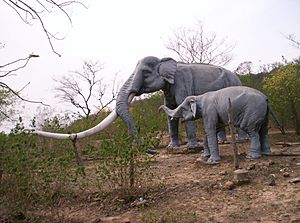
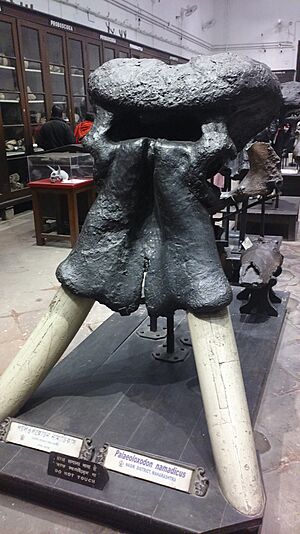
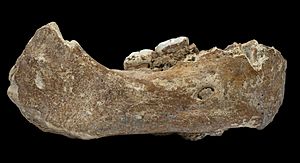
It's hard to know the exact timing of extinctions in India because there isn't enough reliable dating. China has similar issues, but it seems no megafauna survived into the Holocene there. In Southeast Asia and South China, extinctions might have happened because open areas changed into dense forests.
- Hoofed Mammals (Ungulates)
- Even-Toed Hoofed Mammals
- Several Cattle and Antelope (Bovidae) species
- Bos palaesondaicus (an ancestor of the banteng)
- Bison hanaizumiensis
- Cebu tamaraw (Bubalus cebuensis)
- Bubalus grovesi
- Bubalus wansijocki
- Short-horned water buffalo (Bubalus mephistopheles)
- Bubalus palaeokerabau
- Deer (Cervidae)
- Sinomegaceros species (including Sinomegaceros yabei in Japan, and Sinomegaceros ordosianus in China).
- Hippos (Hippopotamidae)
- Hexaprotodon (Indian subcontinent)
- Several Cattle and Antelope (Bovidae) species
- Odd-Toed Hoofed Mammals
- Wild Horses (Equus species)
- Equus namadicus (Indian subcontinent)
- Yunnan horse (Equus yunanensis)
- Giant tapir (Tapirus augustus, Southeast Asia and Southern China)
- Merck's rhinoceros (Stephanorhinus kirchbergensis Eastern Asia)
- Wild Horses (Equus species)
- Even-Toed Hoofed Mammals
- Pangolins (Pholidota)
- Giant Asian pangolin (Manis palaeojavanica)
- Meat-Eating Mammals (Carnivora)
- Dog-like Carnivores (Caniformia)
- Bears (Arctoidea)
- Ailuropoda baconi (an ancestor of the giant panda)
- Bears (Arctoidea)
- Dog-like Carnivores (Caniformia)
- Afrotheria
- Aardvarks (Orycteropodidae/Tubulidentata)
- Aardvark (Orycteropus afer; disappeared from South Asia around 13,000 BCE)
- Elephants and their relatives (Paenungulata)
- Stegodontidae
- Stegodon species (including Stegodon florensis on Flores, Stegodon orientalis in East and Southeast Asia, and Stegodon sp. in the Indian subcontinent)
- Palaeoloxodon species
- Palaeoloxodon namadicus (Indian subcontinent, possibly Southeast Asia)
- Naumann's elephant (Japan)
- Palaeoloxodon huaihoensis (China)
- Stegodontidae
- Aardvarks (Orycteropodidae/Tubulidentata)
- Birds
- Japanese flightless duck (Shiriyanetta hasegawai)
- Leptoptilos robustus
- Reptiles
- Crocodilians
- Alligator munensis
- Crocodilians
- Primates
- Several Ape and Monkey (Simiiformes) species
- Pongo (orangutans)
- Pongo weidenreichi (South China)
- Various Homo species (ancient humans)
- Homo erectus (Java)
- Homo floresiensis (Flores)
- Homo luzonensis (Luzon, Philippines)
- Denisovans (Homo species)
- Pongo (orangutans)
- Several Ape and Monkey (Simiiformes) species
Europe and Northern Asia: Staggered Extinctions
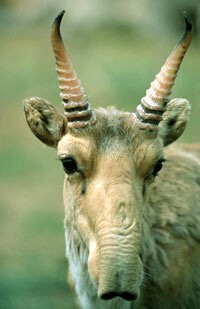

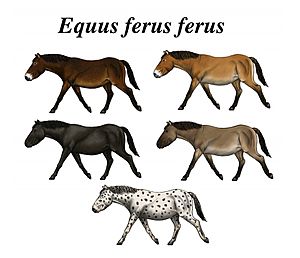
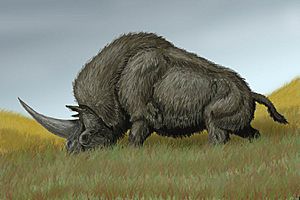
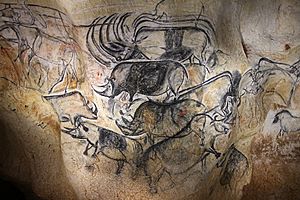
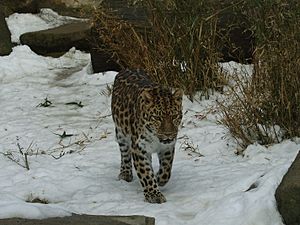
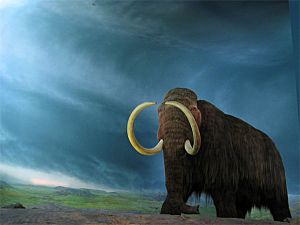
The Palearctic realm covers all of Europe and northern Asia. Extinctions here were more severe than in Africa or South Asia. They happened over tens of thousands of years, from about 50,000 to 10,000 years ago. Animals that liked warmer weather, like the straight-tusked elephant, disappeared earlier. Animals that liked cold, like the woolly mammoth, lasted longer. Climate change was likely a major reason, possibly combined with human hunting.
- Hoofed Mammals (Ungulates)
- Even-Toed Hoofed Mammals
- Various Cattle and Antelope (Bovidae) species
- Steppe bison (Bison priscus)
- Baikal yak (Bos baikalensis)
- European water buffalo (Bubalus murrensis)
- European tahr (Hemitragus cedrensis)
- Giant muskox (Praeovibos priscus)
- Northern saiga antelope (Saiga borealis)
- Twisted-horned antelope (Spirocerus kiakhtensis)
- Goat-horned antelope (Parabubalis capricornis)
- Various deer (Cervidae) species
- Broad-fronted moose (Cervalces latifrons)
- Giant deer (Megaloceros giganteus)
- Praemegaceros savini
- Cretan deer (Candiacervus)
- Haploidoceros mediterraneus
- All native Hippopotamus species
- Hippopotamus amphibius (European range)
- Maltese dwarf hippopotamus (Hippopotamus melitensis)
- Cyprus dwarf hippopotamus (Hippopotamus minor)
- Sicilian dwarf hippopotamus (Hippopotamus pentlandi)
- Camelus knoblochi and other Camelus species
- Various Cattle and Antelope (Bovidae) species
- Odd-Toed Hoofed Mammals
- Various Wild Horses (Equus species)
- Wild horse (Equus ferus subspecies)
- Equus cf. gallicus
- European wild ass (Equus hydruntinus)
- Equus cf. latipes
- Equus lenensis
- Equus cf. uralensis
- All native Rhinoceros (Rhinocerotidae) species
- Elasmotherium
- Woolly rhinoceros (Coelodonta antiquitatis)
- Stephanorhinus species
- Various Wild Horses (Equus species)
- Even-Toed Hoofed Mammals
* Merck's rhinoceros (Stephanorhinus kirchbergensis) * Narrow-nosed rhinoceros (Stephanorhinus hemiotoechus)
- Meat-Eating Mammals (Carnivora)
- Dog-like Carnivores (Caniformia)
- Wild Dogs (Canidae)
- Wolves
- Wild Dogs (Canidae)
- Dog-like Carnivores (Caniformia)
* Cave wolf (Canis lupus spelaeus) * Dire wolf (Aenocyon dirus)
-
-
-
- Dholes
-
-
* European dhole (Cuon alpinus europaeus) * Sardinian dhole (Cynotherium sardous)
-
-
- Bears and Weasels (Arctoidea)
- Various Ursus (Bear) species
- Bears and Weasels (Arctoidea)
-
* Steppe brown bear (Ursus arctos "priscus") * Gamssulzen cave bear (Ursus ingressus) * Pleistocene small cave bear (Ursus rossicus) * Cave bear (Ursus spelaeus) * Giant polar bear (Ursus maritimus tyrannus)
-
-
-
- Weasels and Otters (Musteloidea)
-
-
* Several Otter (Lutrinae) species ** Robust Pleistocene European otter (Cyrnaonyx) ** Algarolutra ** Sardinian giant otter (Megalenhydris barbaricina) ** Sardinian dwarf otter (Sardolutra) ** Cretan otter (Lutrogale cretensis)
-
- Cat-like Carnivores (Feliformia)
- Various Wild Cat (Felidae) species
- Eurasian scimitar cat (Homotherium latidens)
- Cave lynx (Lynx pardinus spelaeus)
- Issoire lynx (Lynx issiodorensis)
- Panthera species
- Various Wild Cat (Felidae) species
- Cat-like Carnivores (Feliformia)
* Cave lion (Panthera spelaea) * European ice age leopard (Panthera pardus spelaea)
-
-
- Hyenas (Herpestoidea)
- Cave hyena (Crocuta crocuta spelaea)
- Hyaena prisca
- Hyenas (Herpestoidea)
-
- All native Elephant (Elephantidae) species
- Mammoths
- Woolly mammoth (Mammuthus primigenius)
- Dwarf Sardinian mammoth (Mammuthus lamarmorai)
- Straight-tusked elephant (Palaeoloxodon antiquus) (Europe)
- Dwarf elephants
- Palaeoloxodon creutzburgi (Crete)
- Cyprus dwarf elephant (Palaeoloxodon cypriotes)
- Palaeoloxodon mnaidriensis (Sicily)
- Mammoths
- Rodents
- Allocricetus bursae
- Cricetus major (or Cricetus cricetus major)
- Dicrostonyx gulielmi (ancestor to the Arctic lemming)
- Giant Eurasian porcupine (Hystrix refossa)
- Leithia species (Maltese and Sicilian giant dormouse)
- Marmota paleocaucasica
- Microtus grafi
- Mimomys species
- M. pyrenaicus
- M. chandolensis
- Pliomys lenki
- Spermophilus citelloides
- Spermophilus severskensis
- Spermophilus superciliosus
- Trogontherium cuiveri
- Rabbits and Pikas (Lagomorpha)
- Lepus tanaiticus (or Lepus timidus tanaiticus)
- Pika (Ochotona) species
- Giant pika (Ochotona whartoni)
- Tonomochota species
- T. khasanensis
- T. sikhotana
- T. major
- Birds
- Primates
- Homo
- Denisovans (Homo species)
- Neanderthals (Homo (sapiens) neanderthalensis; survived until about 40,000 years ago in Spain)
- Homo
North America: Rapid Disappearance
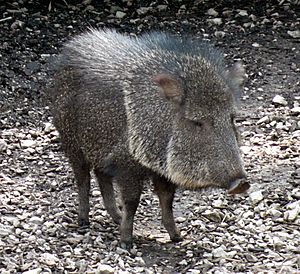
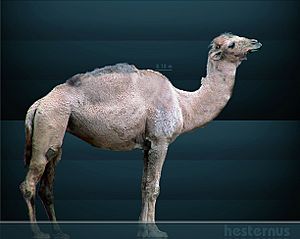
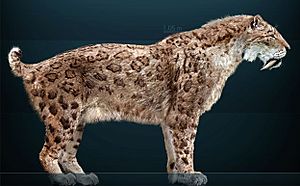
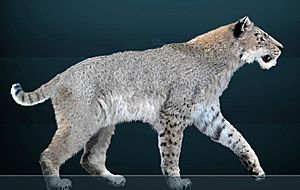
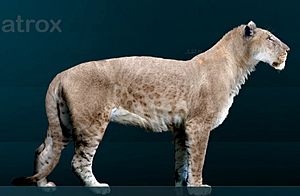
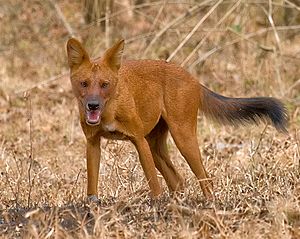
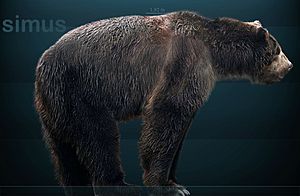
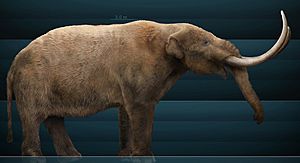
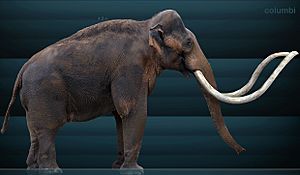
In North America, many extinctions happened quickly at the end of the Late Pleistocene, between 13,800 and 11,400 years ago. This time matches a cold period called the Younger Dryas and the rise of the Clovis culture (early human hunter-gatherers). Scientists still debate whether humans or climate were more important here. About 35 types of large animals disappeared.
Here are some of the North American animals that went extinct (H for plant-eaters, C for meat-eaters):
- Hoofed Mammals (Ungulates)
- Even-Toed Hoofed Mammals
- Various Cattle and Antelope (Bovidae) species
- Most types of Pleistocene bison (only the modern American bison and European bison survived)
- Various Cattle and Antelope (Bovidae) species
- Even-Toed Hoofed Mammals
* Ancient bison (Bison antiquus) (H) * Long-horned/Giant bison (Bison latifrons) (H) * Steppe bison (Bison priscus) (H) * Bison occidentalis (H)
* Giant muskox (Praeovibos priscus) (H) * Shrub-ox (Euceratherium collinum) (H) * Harlan's muskox (Bootherium bombifrons) (H) * Soergel's ox (Soergelia mayfieldi) (H) * Harrington's mountain goat (Oreamnos harringtoni) (H)
-
-
-
- Saiga antelope (Saiga tatarica; disappeared from here) (H)
- Deer
- Stag-moose (Cervalces scotti) (H)
- American mountain deer (Odocoileus lucasi) (H)
- Torontoceros hypnogeos (H)
- Various Antilocapridae (pronghorn relatives)
- Capromeryx (H)
- Stockoceros (H)
- Tetrameryx (H)
- Pacific pronghorn (Antilocapra pacifica) (H)
- Several peccary (Tayassuidae) species
- Flat-headed peccary (Platygonus) (H)
- Long-nosed peccary (Mylohyus) (H)
- Collared peccary (Dicotyles tajacu; disappeared from here, but later returned) (H)
- Various members of Camelidae (camels and llamas)
- Western camel (Camelops hesternus) (H)
- Stilt legged llamas (Hemiauchenia species) (H)
- Stout legged llamas (Palaeolama species) (H)
-
- Odd-Toed Hoofed Mammals
- All native forms of Equidae (horses)
- True horses (Equus cf. ferus) from this time are confusing, with many names like Equus fraternus, Equus scotti, and Equus lambei. They might all be the same species.
- Stilt-legged horse (Haringtonhippus francisci / Equus francisci) (H)
- Tapirs (Tapirus; three species)
- California tapir (Tapirus californicus) (H)
- Merriam's tapir (Tapirus merriami) (H)
- Vero tapir (Tapirus veroensis) (H)
- All native forms of Equidae (horses)
- Extinct Order Notoungulata
- Mixotoxodon (H)
-
- Meat-Eating Mammals (Carnivora)
- Cat-like Carnivores (Feliformia)
- Several Wild Cat (Felidae) species
- Saber-Tooths
- Several Wild Cat (Felidae) species
- Cat-like Carnivores (Feliformia)
* North American saber-toothed cat (Smilodon fatalis) (C) * North American scimitar cat (Homotherium serum) (C)
-
-
-
- American cheetah (Miracinonyx; not a true cheetah)
-
-
* Miracinonyx trumani (C)
-
-
-
- Cougar (Puma concolor; large ancient cougars disappeared, but smaller ones from South America later returned) (C)
- Jaguarundi (Herpailurus yagouaroundi; disappeared, but later returned) (C)
- Margay (Leopardus weidii; disappeared) (C)
- Ocelot (Leopardus pardalis; disappeared, but later returned) (C)
- Eurasian lynx (Lynx lynx; disappeared) (C)
- Jaguars
-
-
* Pleistocene North American jaguar (Panthera onca augusta; other types later returned) (C) * North America Jaguar * Panthera balamoides (possibly the same as a short-faced bear)
-
-
-
- Lions
-
-
* American lion (Panthera atrox; only in North America after 340,000 years ago) (C) * Cave/steppe lion (Panthera spelaea; only in Yukon) (C)
-
- Dog-like Carnivores (Caniformia)
- Wild Dogs (Canidae)
- Dire wolf (Aenocyon dirus) (C)
- Pleistocene coyote (Canis latrans orcutti) (C)
- Megafaunal wolf (e.g., Beringian wolf (Canis lupus subspecies)) (C)
- Dhole (Cuon alpinus; disappeared) (C)
- Protocyon troglodytes (C)
- Bears and Weasels (Arctoidea)
- Weasels and Skunks (Musteloidea)
- Wild Dogs (Canidae)
- Dog-like Carnivores (Caniformia)
* Skunks (Mephitidae) ** Short-faced skunk (Brachyprotoma obtusata) (C) * Weasels (Mustelidae) ** Steppe polecat (Mustela eversmanii; disappeared) (C)
-
-
-
- Various Bear (Ursidae) species
-
-
* Arctodus simus (C) * Florida spectacled bear (Tremarctos floridanus) (C) * South American short-faced bear (Arctotherium wingei) (C) * Giant polar bear (Ursus maritimus tyrannus; possibly lived here) (C)
- Afrotheria
- Anteaters (Orycteropodidae/Tubulidentata)
- Giant anteater (Myrmecophaga tridactyla; disappeared, but later returned) (C)
- Elephants and their relatives (Paenungulata)
- All native species of Proboscidea
- Mastodons
- All native species of Proboscidea
- Anteaters (Orycteropodidae/Tubulidentata)
** American mastodon (Mammut americanum) (H) ** Pacific mastodon (Mammut pacificus) (H) (not sure if this is a real species)
-
-
-
- Gomphotheriidae species
-
-
** Cuvieronius (H)
-
-
-
- Mammoths (Mammuthus) species
-
-
** Columbian mammoth (Mammuthus columbi) (H) ** Pygmy mammoth (Mammuthus exilis) (H) ** Woolly mammoth (Mammuthus primigenius) (H)
-
-
- Sea Cows (Sirenia)
- Dugongidae
- Sea Cows (Sirenia)
-
** Steller's sea cow (Hydrodamalis gigas; disappeared from North America, survived in Beringia until the 1700s) (H)
- Rodents and Rabbits (Euarchontoglires)
- Bats
- Stock's vampire bat (Desmodus stocki) (C)
- Pristine mustached bat (Pteronotus (Phyllodia) pristinus) (C)
- Rodents
- Giant beaver (Castoroides) species
- Castoroides ohioensis (H)
- Castoroides leiseyorum (H)
- Klein's porcupine (Erethizon kleini) (H)
- Giant island deer mouse (Peromyscus nesodytes) (C)
- Neochoerus species (e.g., Pinckney's capybara (Neochoerus pinckneyi)) (H)
- Neochoerus aesopi (H)
- Neotoma findleyi
- Neotoma pygmaea
- Synaptomys australis
- All giant hutia (Heptaxodontidae) species
- Blunt-toothed giant hutia (Amblyrhiza inundata; as big as a black bear) (H)
- Plate-toothed giant hutia (Elasmodontomys obliquus) (H)
- Twisted-toothed mouse (Quemisia gravis) (H)
- Osborn's key mouse (Clidomys osborn's) (H)
- Xaymaca fulvopulvis (H)
- Giant beaver (Castoroides) species
- Rabbits and Pikas (Lagomorphs)
- Aztlan rabbit (Aztlanolagus species) (H)
- Giant pika (Ochotona whartoni) (H)
- Bats
- Shrews and Moles (Eulipotyphla)
- Notiosorex dalquesti
- Notiosorex harrisi
- Armadillos, Sloths, and Anteaters (Xenarthrana)
- All remaining ground sloth species
- Megatheriidae species (giant ground sloths)
- Eremotherium (H)
- Nothrotheriops (H)
- Megalonychid ground sloth species
- Megalonyx (H)
- Nohochichak (H)
- Xibalbaonyx (H)
- Meizonyx
- Mylodontid ground sloth species
- Paramylodon (H)
- Megatheriidae species (giant ground sloths)
- All members of Glyptodontidae (armored relatives of armadillos)
- Glyptotherium (H)
- Beautiful armadillo (Dasypus bellus) (H)
- Pachyarmatherium
- All Pampatheriidae species
- Holmesina (H)
- Pampatherium (H)
- All remaining ground sloth species
- Birds
- Water Fowl
- Ducks
- Bermuda flightless duck (Anas pachyscelus) (H)
- Californian flightless sea duck (Chendytes lawi) (C)
- Mexican stiff-tailed duck (Oxyura zapatima) (H)
- Ducks
- Turkey (Meleagris) species
- Californian turkey (Meleagris californica) (H)
- Meleagris crassipes (H)
- Various Gruiformes species
- All cave rail (Nesotrochis) species
- Antillean cave rail (Nesotrochis debooyi) (C)
- Barbados rail (C)
- Cuban flightless crane (Antigone cubensis) (H)
- La Brea crane (Grus pagei) (H)
- All cave rail (Nesotrochis) species
- Various flamingo (Phoenicopteridae) species
- Minute flamingo (Phoenicopterus minutus) (C)
- Cope's flamingo (Phoenicopterus copei) (C)
- Dow's puffin (Fratercula dowi) (C)
- Ancient Mexican diver species
- Plyolimbus baryosteus (C)
- Podiceps species
- Podiceps parvus (C)
- Storks
- La Brea/Asphalt stork (Ciconia maltha) (C)
- Wetmore's stork (Mycteria wetmorei) (C)
- Ancient Mexican cormorants species (genus Phalacrocorax)
- Phalacrocorax goletensis (C)
- Phalacrocorax chapalensis (C)
- All remaining teratorn (Teratornithidae) species (giant flying birds)
- Aiolornis incredibilis (C)
- Cathartornis gracilis (C)
- Oscaravis olsoni (C)
- Teratornis merriami (C)
- Teratornis woodburnensis (C)
- Several New World vultures (Cathartidae) species
- Pleistocene black vulture (Coragyps occidentalis subspecies) (C)
- Megafaunal Californian condor (Gymnogyps amplus) (C)
- Clark's condor (Breagyps clarki) (C)
- Cuban condor (Gymnogyps varonai) (C)
- Several Accipitridae (hawks and eagles) species
- American neophrone vulture (Neophrontops americanus) (C)
- Woodward's eagle (Amplibuteo woodwardi) (C)
- Cuban great hawk (Buteogallus borrasi) (C)
- Daggett's eagle (Buteogallus daggetti) (C)
- Fragile eagle (Buteogallus fragilis) (C)
- Cuban giant hawk (Gigantohierax suarezi) (C)
- Errant eagle (Neogyps errans) (C)
- Grinnell's crested eagle (Spizaetus grinnelli) (C)
- Willett's hawk-eagle (Spizaetus willetti) (C)
- Caribbean titan hawk (Titanohierax) (C)
- Several owl (Strigiformes) species
- Brea miniature owl (Asphaltoglaux) (C)
- Kurochkin's pygmy owl (Glaucidium kurochkini) (C)
- Brea owl (Oraristix brea) (C)
- Cuban giant owl (Ornimegalonyx) (C)
- Bermuda flicker (Colaptes oceanicus) (C)
- Several caracara species
- Bahaman terrestrial caracara (Caracara species) (C)
- Puerto Rican terrestrial caracara (Caracara species) (C)
- Jamaican caracara (Carcara tellustris) (C)
- Cuban caracara (Milvago species) (C)
- Hispaniolan caracara (Milvago species) (C)
- Parrots (Psittaciformes)
- Mexican thick-billed parrot (Rhynchopsitta phillipsi) (H)
- Water Fowl
- Several giant tortoise species
- Hesperotestudo (H)
- Gopherus species
- Gopherus donlaloi (H)
- Chelonoidis species
- Chelonoidis marcanoi (H)
- Chelonoidis alburyorum (H)
Some animals survived, like bison (H), grey wolf (C), lynx (C), grizzly bear (C), American black bear (C), deer (like caribou, moose, elk, Odocoileus species) (H), pronghorn (H), white-lipped peccary (H), muskox (H), bighorn sheep (H), and mountain goat (H). Some animals that disappeared later returned from South America, like the cougar (C), jaguar (C), giant anteater (C), collared peccary (H), ocelot (C) and jaguarundi (C). Most of these survivors had ancestors from Asia who had already dealt with human hunters.
The pronghorn is the second-fastest land mammal, which might have helped it escape hunters. The survival of bison is harder to explain, as they arrived in North America less than 240,000 years ago. This means they hadn't been exposed to human hunters for long. Since ancient bison evolved into modern bison, there wasn't a complete extinction of bison across the continent.
The Clovis culture of early Americans is linked to these extinctions. They used spear throwers to hunt large animals. A main criticism of the "overkill" idea is that there weren't enough humans to cause such a big impact. However, this doesn't mean climate change is the only answer. A combination of both factors is possible. Hunting would have been easier if animal populations were already stressed by climate change.
South America: Huge Losses
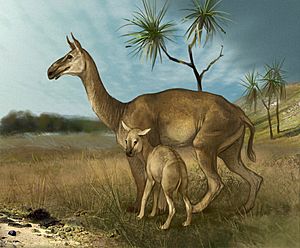

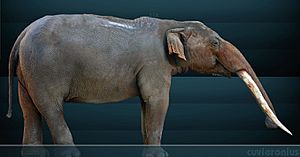
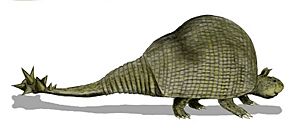
South America lost a huge number of its megafauna, about 83%. These extinctions happened between 13,000 and 10,000 years ago. This time matches the end of a cold period and the spread of Fishtail projectile points, which were spear tips used for hunting big game. Even though these points were used for hunting, there's not much direct proof of humans hunting extinct megafauna. These spear points quickly disappeared after the megafauna did, replaced by tools for smaller prey. While humans were traditionally seen as less of a cause here than in North America, new studies are starting to challenge this.
- Hoofed Mammals (Ungulates)
- Even-Toed Hoofed Mammals
- Several Deer (Cervidae) species
- Morenelaphus
- Antifer
- Agalmaceros blicki
- Odocoileus salinae
- Various Camel (Camelidae) species
- Eulamaops
- Stilt legged llama Hemiauchenia
- Stout legged llama Palaeolama
- Several Deer (Cervidae) species
- Odd-Toed Hoofed Mammals
- Several species of Tapirs (Tapiridae)
- Tapirus rondoniensis
- Tapirus cristatellus
- All Pleistocene wild horse genera (Equidae)
- Equus neogeus
- Hippidion
- Several species of Tapirs (Tapiridae)
- Even-Toed Hoofed Mammals
* Hippidion devillei * Hippidion principale * Hippidion saldiasi
-
- All remaining Meridiungulata genera (unique South American hoofed mammals)
- Order Litopterna
- Macraucheniidae
- Order Litopterna
- All remaining Meridiungulata genera (unique South American hoofed mammals)
* Macrauchenia * Macraucheniopsis * Xenorhinotherium
-
-
-
- Proterotheriidae
-
-
* Neolicaphrium recens
-
-
- Order Notoungulata
- Toxodontidae
- Order Notoungulata
-
* Piauhytherium (some think this is the same as Trigodonops) * Mixotoxodon * Toxodon * Trigodonops
- Meat-Eating Mammals (Carnivora)
- Cat-like Carnivores (Feliformia)
- Several Wild Cat (Felidae) species
- Saber-toothed cat (Smilodon) species
- Several Wild Cat (Felidae) species
- Cat-like Carnivores (Feliformia)
* North American saber-toothed cat (Smilodon fatalis) * South American saber-toothed cat (Smilodon populator)
-
-
-
- Patagonian jaguar (Panthera onca mesembrina) (some think these might be American lion remains)
-
- Dog-like Carnivores (Caniformia)
- Wild Dogs (Canidae)
- Dire wolf (Aenocyon dirus)
- Nehring's wolf (Canis nehringi)
- Protocyon species
- Wild Dogs (Canidae)
-
* Protocyon trogolodytes * Protocyon tarijense
-
-
-
- Dusicyon avus
- Pleistocene bush dog (Speothos pacivorus)
- Bears (Arctoidea)
- South American short-faced bear (Arctotherium species)
-
-
* Arctotherium bonairense * Arctotherium tarijense * Arctotherium wingei
- Rodents
- Neochoerus
- Bats
- Giant vampire bat (Desmodus draculae)
- All remaining Gomphotheridae species (elephant relatives)
- Cuvieronius
- Notiomastodon
- Armadillos, Sloths, and Anteaters (Xenarthrans)
- All remaining ground sloth genera
- Megatheriidae species
- Eremotherium
- Megatherium
- Nothrotheriidae species
- Nothropus
- Nothrotherium
- Megalonychidae species
- Ahytherium
- Australonyx
- Diabolotherium
- Megistonyx
- Valgipes
- Mylodontidae species
- Catonyx
- Glossotherium
- Lestodon
- Mylodon
- Scelidotherium
- Scelidodon
- Mylodonopsis
- Ocnotherium
- Megatheriidae species
- All remaining Glyptodontinae species (armored mammals)
- Doedicurus
- Glyptodon/Chlamydotherium
- Heteroglyptodon
- Hoplophorus
- Lomaphorus
- Neosclerocalyptus
- Neuryurus
- Panochthus
- Parapanochthus
- Plaxhaplous
- Sclerocalyptus
- Several Dasypodidae (armadillo) species
- Beautiful armadillo (Dasypus bellus)
- Eutatus
- Pachyarmatherium
- Propaopus
- All Pampatheriidae species (giant armadillo relatives)
- Holmesina
- Pampatherium
- Tonnicinctus
- All remaining ground sloth genera
- Birds
- Psilopterus (small terror bird, but its age is debated)
- Various Caracarinae species
- Venezuelan caracara (Caracara major)
- Seymour's caracara (Caracara seymouri)
- Peruvian caracara (Milvago brodkorbi)
- Various Cathartidae (New World vulture) species
- Pampagyps imperator
- Geronogyps reliquus
- Wingegyps cartellei
- Pleistovultur nevesi
- Crocodiles and Alligators (Crocodilia)
- Caiman venezuelensis
- Chelonoidis lutzae (Argentina)
Australia and Pacific Islands: Early Extinctions
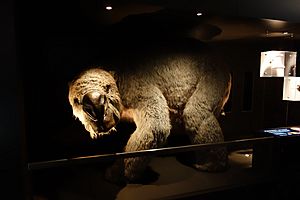
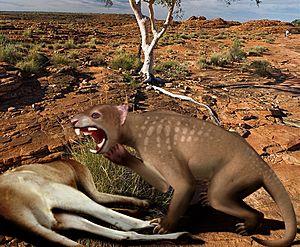
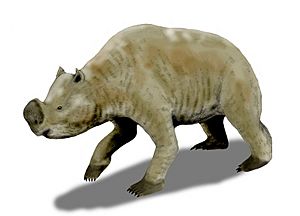
It's hard to know the exact timelines for megafauna extinctions in Australia because there aren't many reliably dated bone finds. This has led to different ideas among researchers.
There are three main ideas about why the Australian megafauna disappeared:
- They went extinct when the Aboriginal Australians first arrived.
- They went extinct due to natural climate change.
- A combination of human impact and natural climate change caused the extinctions.
Evidence for the second idea (climate change) suggests that some megafauna survived until 40,000 years ago. This is 30,000 years after humans first arrived in Australia, meaning they lived together for a long time. Fossils and ocean sediment show that many large mammals existed in southwest Australia until about 45,000 years ago. Then, their populations crashed quickly. At South Walker Creek, a megafauna site in northern Australia, at least 16 species survived until 40,000 years ago. There's no strong proof of humans living there at that time. However, there is evidence of major environmental problems at South Water Creek 40,000 years ago, like more fires, less grassland, and less fresh water. These changes were happening across Australia, supporting the climate change idea. Australia became much drier, leading to less water, more droughts, changes in plants, and more fires. These changes were too much for 90% of megafauna species.
The third idea (human and climate combined) suggests that since much of Australia is dry, megafauna and humans would have competed for fresh water. This could have led to more hunting. Also, early humans used fire to clear land. This further reduced grasslands, which were important food for plant-eating megafauna. While there's no full agreement, it's likely that humans and climate change together caused the extinctions. Climate change made the ecosystem weak, and human hunting and fire use finished them off.
Studies of fossilized teeth from Cuddie Springs in Australia support the climate change idea. They show that the diet of megafauna changed as the climate became drier, leading to less of their preferred food. This stress likely contributed to their decline.
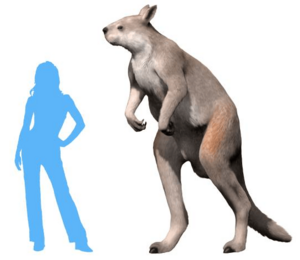

In Sahul (Australia and New Guinea), the extinctions happened earlier than elsewhere. Most evidence points to a 20,000-year period after humans arrived around 63,000 BCE. In other Pacific islands, animals also disappeared quickly when humans arrived in the late Pleistocene and early Holocene.
- Marsupials
- Various members of Diprotodontidae (giant wombat-like animals)
- Diprotodon
- Hulitherium tomasetti
- Maokopia ronaldi
- Zygomaturus
- Palorchestes ("marsupial tapir")
- Various members of Vombatidae (wombats)
- Lasiorhinus angustidens (giant wombat)
- Phascolonus (giant wombat)
- Ramasayia magna (giant wombat)
- Vombatus hacketti (Hackett's wombat)
- Warendja wakefieldi (dwarf wombat)
- Sedophascolomys (giant wombat)
- Phascolarctos stirtoni (giant koala)
- Marsupial lion (Thylacoleo carnifex)
- Various members of Macropodidae (kangaroos and wallabies)
- Procoptodon (short-faced kangaroos) (e.g., Procoptodon goliah)
- Sthenurus (giant kangaroo)
- Simosthenurus (giant kangaroo)
- Various Macropus (giant kangaroo) species (e.g., Macropus ferragus, Macropus titan, Macropus pearsoni)
- Protemnodon (giant wallaby)
- Troposodon (wallaby)
- Bohra (giant tree kangaroo)
- Propleopus oscillans (omnivorous, giant musky rat-kangaroo)
- Nombe
- Congruus
- Various forms of Sarcophilus (Tasmanian devil)
- Sarcophilus laniarius (25% larger than modern species, might be the same as living Tasmanian devil)
- Sarcophilus moornaensis
- Various members of Diprotodontidae (giant wombat-like animals)
- Monotremes: egg-laying mammals.
- Echidna
- Murrayglossus hacketti (giant echidna)
- Megalibgwilia ramsayi
- Echidna
- Birds
- Pygmy Cassowary (Casuarius lydekkeri)
- Genyornis (a 2-meter-tall dromornithid, or "thunder bird")
- Giant malleefowl (Progura gallinacea)
- Cryptogyps lacertosus
- Dynatoaetus gaffae
- Several Phoenicopteridae (flamingo) species
- Xenorhynchopsis species (Australian flamingo)
- Xenorhynchopsis minor
- Xenorhynchopsis tibialis
- Reptiles
- Crocodiles and Alligators
- Ikanogavialis (the last fully marine crocodile)
- Pallimnarchus (Australian freshwater crocodile)
- Quinkana (Australian land crocodile, a top predator)
- Volia (a 2-3 meter long crocodile, top predator of Pleistocene Fiji)
- Mekosuchus
- Mekosuchus inexpectatus (New Caledonian land crocodile)
- Mekosuchus kalpokasi (Vanuatu land crocodile)
- Varanus sp. (Pleistocene and Holocene New Caledonia)
- Megalania (Varanus pricus) (a giant predatory monitor lizard, bigger than a Komodo dragon)
- Snakes
- Several species of Meiolaniidae (giant armored turtles)
- Meiolania
- Ninjemys
- Crocodiles and Alligators
What Caused the Extinctions?
Human Activity and Hunting
The hunting hypothesis suggests that humans hunted large plant-eaters (megaherbivores) until they disappeared. This then caused the extinction of meat-eaters and scavengers that relied on those large animals. This idea blames early humans for the megafauna extinction. One version, called blitzkrieg, says this happened very quickly.
Evidence for this includes:
- Fossils of megafauna found with human remains.
- Arrowheads and tool marks found on megafauna bones.
- European cave paintings showing humans hunting these animals.
Also, areas where humans first evolved (like parts of Asia and Africa) still have more of their ancient megafauna (like elephants and rhinos). Other places, like Australia, the Americas, Madagascar, and New Zealand, where humans arrived later, lost many more. This suggests that when a new, adaptable predator (humans) moved into an ecosystem, it had a big impact.
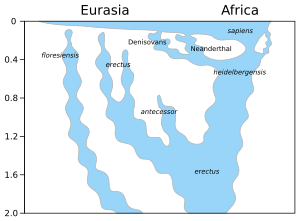
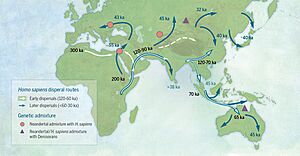
The timing of human arrival and extinctions often matches up. For example, in Australia, the mammal extinction wave around 50,000 years ago happened when humans arrived, not during known climate changes. Also, giant kangaroos disappeared faster on the Australian mainland than on Tasmania, which humans reached later. A 2015 study found strong links between human spread and species extinction, suggesting humans were the main cause, with climate change making it worse. A 2020 study in Science Advances found that human population size and activities, not climate change, caused rising mammal extinction rates over the last 126,000 years. About 96% of all mammal extinctions in this time are linked to humans.
The fact that mostly larger animals went extinct also supports the human activity idea, as large animals are often easier to hunt.
However, there are arguments against the hunting hypothesis. There's not much proof of humans hunting megafauna other than mammoths, mastodons, and bison in North America. For example, camels and horses were common, but there's little evidence of them being hunted. Supporters of the overkill idea say this is because the extinctions happened so fast, and it's rare to find animal remains with signs of butchery. Some experts also argue that early human populations were too small to cause such widespread extinctions, and that hunters wouldn't waste so much meat.
Second-Order Predation: A Chain Reaction
The Second-Order Predation Hypothesis suggests a different way humans caused extinctions. When humans arrived in new places, they hunted other predators. This was successful in places like the Old World. But in the New World, where animals weren't used to humans, killing off too many predators upset the natural balance.
Here's how it might have worked:
- Humans competed with existing predators for food.
- Humans started killing these other predators.
- With fewer natural predators, the populations of plant-eating animals grew too large.
- These plant-eaters ate too much vegetation, damaging the environment.
- The environment couldn't support them anymore, and many plant-eaters starved.
- This change in plant life also affected the climate, making it drier.
This idea is supported by computer models. It also helps explain why bison populations increased a lot.
However, this idea has been criticized. Some say the model assumes that small animals with many babies help feed predators, which then affects larger animals. Also, the idea that predators control population sizes isn't always true in modern ecosystems. The hypothesis also assumes climate change reduced plants, but the melting ice actually opened up more land in North America. These changes didn't cause many extinctions of small animals, which are usually more sensitive to habitat changes.
Climate Change: A Natural Shift
In the past, when scientists first learned about ice ages, they thought the end of the Pleistocene ice age explained the extinctions.
The most obvious change was a big increase in temperature. Between 15,000 and 10,000 years ago, global temperatures rose by about 6°C. This was thought to kill off cold-adapted mammals. Their thick fur, which kept them warm, might have made them overheat. Large mammals, with their smaller surface area-to-volume ratio, would have struggled more with heat. Studies show that rapid warming events, with temperature changes up to 16°C, had a big impact.
Other scientists suggest that more extreme weather (hotter summers, colder winters) or changes in rainfall caused the extinctions. Vegetation changed from mixed forests to separate grasslands and woodlands. This might have changed the available food. Shorter growing seasons could have harmed large plant-eaters and made many others smaller. In this case, animals like bison would have done better than horses and elephants, because they can get more nutrition from tough, fibrous plants. When plants become more specialized, animals that can't easily change their diet might struggle to find enough food.
Increased dryness also meant less predictable rainfall, limiting when plants were available. This could hurt large animals because they have longer, less flexible breeding times. They might have had babies when there wasn't enough food or water. Smaller mammals, with shorter life cycles and reproductive cycles, could adapt better.
Critics argue that since there were many ice ages before, it's unlikely that only the last one caused such extinctions. One study suggests that the megafauna of the last ice age might have been more vulnerable than those in earlier warm periods.
Studies show that current temperatures are not higher than in previous warm periods, yet most large mammals survived those earlier warm periods. Also, mammoths on Wrangel Island and St. Paul Island survived climate changes in areas without humans. This wouldn't be expected if climate change alone was the cause, unless their island climates offered special protection.
Critics also point out problems with the "continentality" idea. Large plant-eaters thrived in cold, dry Siberia, which has a very continental climate. Also, the animals that went extinct should have done well when grasslands increased, as grass was their main food. While vegetation became more specialized, the amount of grass actually increased, which should have been good for horses and mammoths. Modern horses, reintroduced to North America, thrive in these environments. However, this argument ignores that modern horses don't compete with extinct animals like ground sloths and mammoths.
Some evidence from Australia goes against the climate change idea. The climate during the extinctions (40,000–50,000 years ago) was similar to today's, and the extinct animals were adapted to dry conditions. All extinctions happened in a short time, when humans arrived. Fire, started by humans, might have been the main cause in a landscape not used to fire.
Evidence from mastodon tusks in the American Great Lakes also challenges the climate change idea. Before they went extinct, mastodons matured earlier. This is the opposite of what you'd expect if they were stressed by a worsening environment. It fits better with their population being reduced by human hunting.
It seems neither hunting nor climate change can fully explain everything. Plant-eaters that ate a mix of plants, and non-ruminant grazers (like horses and elephants) suffered most. Ruminant grazers (like bison) survived better. However, a broader hunting idea might explain this, as human-caused changes to vegetation would harm certain plant-eaters more.
Disease: A Hidden Threat
The hyperdisease hypothesis suggests that diseases brought by newly arrived humans or their animals (like dogs) caused the extinction of large mammals. In recent times, diseases have wiped out vulnerable species. For example, bird malaria greatly reduced bird populations in Hawaii. This idea proposes that one or more very strong diseases were introduced to native mammals, causing extinctions. Larger species were more affected because they have slower life cycles and smaller populations, making them less able to recover. Humans are thought to be the cause because earlier animal migrations into North America didn't cause extinctions.
If disease was responsible, it would need to meet several conditions:
- The disease must have a stable "carrier" in another species, meaning it can survive even when there are no sick animals.
- It must spread easily and infect almost all animals it encounters.
- It must be very deadly, killing 50-75% of infected animals.
- It must be able to infect many different animal species without being a serious threat to humans.
However, there are arguments against the hyperdisease hypothesis. Diseases usually have to be extremely strong to wipe out an entire group of animals. It would need to be very specific, killing off certain wolves or goats, but not very similar species. It would also need to kill flightless birds but not closely related flying birds. And it would need to infect many different types of animals (birds, marsupials, mammals, turtles, crocodiles) while leaving other closely related species unharmed. No known disease acts this way. Also, animals constantly moved between Asia and North America, so their immune systems should have been ready for new diseases. The dog-specific disease idea doesn't explain extinctions in Australia, where dogs arrived much later than humans.
How Extinctions Changed the World
The disappearance of megafauna might have caused the "mammoth steppe" (a vast grassland) to vanish, rather than the other way around. Today, Alaska's soil is poor and can't support large animals. Some think this caused the extinctions. But it might be that the loss of large plant-eaters, who broke up the frozen ground, led to the poor soil. In the Arctic, where trucks break up the permafrost, diverse plants and animals can grow. Adding fertilizer to Alaskan soil can also make grass grow again, like in the mammoth steppe era. So, the loss of megafauna and their dung might have led to low soil nutrients today.
Megafauna also played a big role in moving nutrients around ecosystems. They carried minerals from rich areas to poorer ones by eating and then releasing them through waste. In the Amazon Basin, this nutrient movement dropped by over 98% after megafauna disappeared about 12,500 years ago. This decrease in nutrient transport likely had a big impact on the region's environment.
Large groups of mega-plant-eaters could have added a lot of methane (a greenhouse gas) to the atmosphere. Modern cows produce methane during digestion. In the time of dinosaurs, giant plant-eaters might have released 520 million tons of methane yearly, contributing to a warmer climate.
Recent studies suggest that the extinction of megafauna might have reduced atmospheric methane. One study estimated that the loss of American bison in North America caused a decrease of 2.2 million tons of methane per year. Another study suggests that the extinction of megafauna in the Americas, after early humans arrived, reduced methane production by about 9.6 million tons per year. This suggests that the lack of megafauna methane might have contributed to the sudden cooling at the start of the Younger Dryas. The drop in atmospheric methane at that time was much faster than any other in the last half-million years, suggesting something unusual happened.
Images for kids
-
Quinkana was one of the last surviving land crocodiles.


